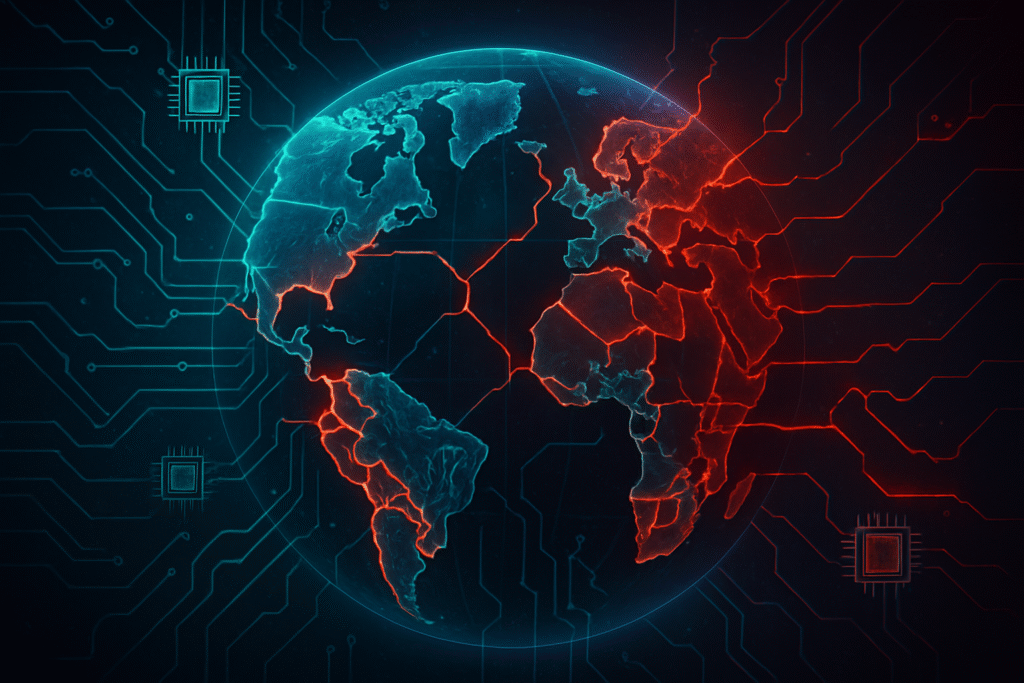
As of late 2025, the global landscape of artificial intelligence is increasingly defined not just by technological breakthroughs but by the intricate dance of international relations and national security interests. The geopolitical tug-of-war over advanced semiconductors, the literal building blocks of AI, has intensified, creating a "Silicon Curtain" that threatens to bifurcate global tech ecosystems. This high-stakes competition, primarily between the United States and China, is fundamentally altering where and how AI chips are produced, traded, and innovated, with profound implications for AI companies, tech giants, and startups worldwide. The immediate significance is a rapid recalibration of global technology supply chains and a heightened focus on techno-nationalism, placing national security at the forefront of policy decisions over traditional free trade considerations.
Geopolitical Dynamics: The Battle for Silicon Supremacy
The current geopolitical environment is characterized by an escalating technological rivalry, with advanced semiconductors for AI chips at its core. This struggle involves key nations and their industrial champions, each vying for technological leadership and supply chain resilience. The United States, a leader in chip design through companies like Nvidia and Intel, has aggressively pursued policies to limit rivals' access to cutting-edge technology while simultaneously boosting domestic manufacturing through initiatives such as the CHIPS and Science Act. This legislation, enacted in 2022, has allocated over $52 billion in subsidies and tax credits to incentivize chip manufacturing within the US, alongside $200 billion for research in AI, quantum computing, and robotics, aiming to produce approximately 20% of the world's most advanced logic chips by the end of the decade.
In response, China, with its "Made in China 2025" strategy and substantial state funding, is relentlessly pushing for self-sufficiency in high-tech sectors, including semiconductors. Companies like Huawei and Semiconductor Manufacturing International Corporation (SMIC) are central to these efforts, striving to overcome US export controls that have targeted their access to advanced chip-making equipment and high-performance AI chips. These restrictions, which include bans on the export of top-tier GPUs like Nvidia's A100 and H100 and critical Electronic Design Automation (EDA) software, aim to slow China's AI development, forcing Chinese firms to innovate domestically or seek alternative, less advanced solutions.
Taiwan, home to Taiwan Semiconductor Manufacturing Company (TSMC), holds a uniquely pivotal position in this global contest. TSMC, the world's largest contract manufacturer of integrated circuits, produces over 90% of the world's most advanced chips, including those powering AI applications from major global tech players. This concentration makes Taiwan a critical geopolitical flashpoint, as any disruption to its semiconductor production would have catastrophic global economic and technological consequences. Other significant players include South Korea, with Samsung (a top memory chip maker and foundry player) and SK Hynix, and the Netherlands, home to ASML, the sole producer of extreme ultraviolet (EUV) lithography machines essential for manufacturing the most advanced semiconductors. Japan also plays a crucial role as a partner in limiting China's access to cutting-edge equipment and a recipient of investments aimed at strengthening semiconductor supply chains.
The Ripple Effect: Impact on AI Companies and Tech Giants
The intensifying geopolitical competition has sent significant ripple effects throughout the AI industry, impacting established tech giants, innovative startups, and the competitive landscape itself. Companies like Nvidia (the undisputed leader in AI computing with its GPUs) and AMD are navigating complex export control regulations, which have necessitated the creation of "China-only" versions of their advanced chips with reduced performance to comply with US mandates. This has not only impacted their revenue streams from a critical market but also forced strategic pivots in product development and market segmentation.
For major AI labs and tech companies, the drive for supply chain resilience and national technological sovereignty is leading to significant strategic shifts. Many hyperscalers, including Google, Microsoft, and Amazon, are heavily investing in developing their own custom AI accelerators and chips to reduce reliance on external suppliers and mitigate geopolitical risks. This trend, while fostering innovation in chip design, also increases development costs and creates potential fragmentation in the AI hardware ecosystem. Intel, historically a CPU powerhouse, is aggressively expanding its foundry services to compete with TSMC and Samsung, aiming to become a major player in the contract manufacturing of AI chips and reduce global reliance on a single region.
The competitive implications are stark. While Nvidia's dominance in high-end AI GPUs remains strong, the restrictions and the rise of in-house chip development by hyperscalers pose a long-term challenge. Samsung is making high-stakes investments in its foundry services for AI chips, aiming to compete directly with TSMC, but faces hurdles from US sanctions affecting sales to China and managing production delays. SK Hynix (South Korea) has strategically benefited from its focus on high-bandwidth memory (HBM), a crucial component for AI servers, gaining significant market share by aligning with Nvidia's needs. Chinese AI companies, facing restricted access to advanced foreign chips, are accelerating domestic innovation, optimizing their AI models for locally produced hardware, and investing heavily in domestic chip design and manufacturing capabilities, potentially fostering a parallel, albeit less advanced, AI ecosystem.
Wider Significance: A New AI Landscape Emerges
The geopolitical shaping of semiconductor production and trade extends far beyond corporate balance sheets, fundamentally altering the broader AI landscape and global technological trends. The emergence of a "Silicon Curtain" signifies a world increasingly fractured into distinct technology ecosystems, with parallel supply chains and potentially divergent standards. This bifurcation challenges the historically integrated and globalized nature of the tech industry, raising concerns about interoperability, efficiency, and the pace of global innovation.
At its core, this shift elevates semiconductors and AI to the status of unequivocal strategic assets, placing national security at the forefront of policy decisions. Governments are now prioritizing techno-nationalism and economic sovereignty over traditional free trade considerations, viewing control over advanced AI capabilities as paramount for defense, economic competitiveness, and political influence. This perspective fuels an "AI arms race" narrative, where nations are striving for technological dominance across various sectors, intensifying the focus on controlling critical AI infrastructure, data, and talent.
The economic restructuring underway is profound, impacting investment flows, corporate strategies, and global trade patterns. Companies must now navigate complex regulatory environments, balancing geopolitical alignments with market access. This environment also brings potential concerns, including increased production costs due to efforts to onshore or "friendshore" manufacturing, which could lead to higher prices for AI chips and potentially slow down the widespread adoption and advancement of AI technologies. Furthermore, the concentration of advanced chip manufacturing in geopolitically sensitive regions like Taiwan creates significant vulnerabilities, where any conflict could trigger a global economic catastrophe far beyond the tech sector. This era marks a departure from previous AI milestones, where breakthroughs were largely driven by open collaboration and scientific pursuit; now, national interests and strategic competition are equally powerful drivers, shaping the very trajectory of AI development.
Future Developments: Navigating a Fractured Future
Looking ahead, the geopolitical currents influencing AI chip availability and innovation are expected to intensify, leading to both near-term adjustments and long-term structural changes. In the near term, we can anticipate further refinements and expansions of export control regimes, with nations continually calibrating their policies to balance strategic advantage against the risks of stifling domestic innovation or alienating allies. The US, for instance, may continue to broaden its list of restricted entities and technologies, while China will likely redouble its efforts in indigenous research and development, potentially leading to breakthroughs in less advanced but still functional AI chip designs that circumvent current restrictions.
The push for regional self-sufficiency will likely accelerate, with more investments flowing into semiconductor manufacturing hubs in North America, Europe, and potentially other allied nations. This trend is expected to foster greater diversification of the supply chain, albeit at a higher cost. We may see more strategic alliances forming among like-minded nations to secure critical components and share technological expertise, aimed at creating resilient supply chains that are less susceptible to geopolitical shocks. Experts predict that this will lead to a more complex, multi-polar semiconductor industry, where different regions specialize in various parts of the value chain, rather than the highly concentrated model of the past.
Potential applications and use cases on the horizon will be shaped by these dynamics. While high-end AI research requiring the most advanced chips might face supply constraints in certain regions, the drive for domestic alternatives could spur innovation in optimizing AI models for less powerful hardware or developing new chip architectures. Challenges that need to be addressed include the immense capital expenditure required to build new fabs, the scarcity of skilled labor, and the ongoing need for international collaboration on fundamental research, even amidst competition. What experts predict will happen next is a continued dance between restriction and innovation, where geopolitical pressures inadvertently drive new forms of technological advancement and strategic partnerships, fundamentally reshaping the global AI ecosystem for decades to come.
Comprehensive Wrap-up: The Dawn of Geopolitical AI
In summary, the geopolitical landscape's profound impact on semiconductor production and trade has ushered in a new era for artificial intelligence—one defined by strategic competition, national security imperatives, and the restructuring of global supply chains. Key takeaways include the emergence of a "Silicon Curtain" dividing technological ecosystems, the aggressive use of export controls and domestic subsidies as tools of statecraft, and the subsequent acceleration of in-house chip development by major tech players. The centrality of Taiwan's TSMC to the advanced chip market underscores the acute vulnerabilities inherent in the current global setup, making it a focal point of international concern.
This development marks a significant turning point in AI history, moving beyond purely technological milestones to encompass a deeply intertwined geopolitical dimension. The "AI arms race" narrative is no longer merely metaphorical but reflects tangible policy actions aimed at securing technological supremacy. The long-term impact will likely see a more fragmented yet potentially more resilient global semiconductor industry, with increased regional manufacturing capabilities and a greater emphasis on national control over critical technologies. However, this comes with the inherent risks of increased costs, slower global innovation due to reduced collaboration, and the potential for greater international friction.
In the coming weeks and months, it will be crucial to watch for further policy announcements regarding export controls, the progress of major fab construction projects in the US and Europe, and any shifts in the strategic alliances surrounding semiconductor supply chains. The adaptability of Chinese AI companies in developing domestic alternatives will also be a key indicator of the effectiveness of current restrictions. Ultimately, the future of AI availability and innovation will be a testament to how effectively nations can balance competition with the undeniable need for global cooperation in advancing a technology that holds immense promise for all of humanity.
This content is intended for informational purposes only and represents analysis of current AI developments.
TokenRing AI delivers enterprise-grade solutions for multi-agent AI workflow orchestration, AI-powered development tools, and seamless remote collaboration platforms.
For more information, visit https://www.tokenring.ai/.


















